Spatial Mapping of Soil CO2 Flux in the Yellow River Delta Farmland of China Using Multi-Source Optical Remote Sensing Data
Abstract
:1. Introduction
2. Materials and Methods
2.1. Study Area
2.2. Soil CO2 Collection
2.3. Multi-Source Remote Sensing Variables
2.4. Auxiliary Variables
2.5. Machine Learning
2.5.1. Tree-Structured Parzen Estimator
2.5.2. eXtreme Gradient Boosting
2.6. Verification
2.7. SHAP Analysis
3. Results
3.1. Statistical Analysis
3.2. Accuracy Evaluation of Single-Satellite Prediction
3.3. Hyperparameter Optimization
3.4. Variable Importance
3.5. Multi-Satellite Prediction Accuracy and Variable Importance
3.6. The Spatial Mapping of Soil CO2 Flux Using the TPE-XGBoost Model
4. Discussion
4.1. Effects of Auxiliary Variables on Soil CO2 Flux
4.2. Limitations
5. Conclusions
Author Contributions
Funding
Data Availability Statement
Conflicts of Interest
References
- Change, On Climate. Intergovernmental panel on climate change. World Meteorol. Organ. 2007, 52, 1–43.
- Fan, R.; Zhang, B.; Li, J.; Zhang, Z.; Liang, A. Straw-derived biochar mitigates CO2 emission through changes in soil pore structure in a wheat-rice rotation system. Chemosphere 2020, 243, 125329. [Google Scholar] [CrossRef]
- Forte, A.; Fiorentino, N.; Fagnano, M.; Fierro, A. Mitigation impact of minimum tillage on CO2 and N2O emissions from a Mediterranean maize cropped soil under low-water input management. Soil. Till. Res. 2017, 166, 167–178. [Google Scholar] [CrossRef]
- De Stefano, A.; Jacobson, M.G. Soil carbon sequestration in agroforestry systems: A meta-analysis. Agroforest. Syst. 2018, 92, 285–299. [Google Scholar] [CrossRef]
- Deng, Y.; He, Z.; Xiong, J.; Yu, H.; Xu, M.; Hobbie, S.E.; Reich, P.B.; Schadt, C.W.; Kent, A.; Pendall, E. Elevated carbon dioxide accelerates the spatial turnover of soil microbial communities. Glob. Chang. Biol. 2016, 22, 957–964. [Google Scholar] [CrossRef]
- Okubo, T.; Liu, D.; Tsurumaru, H.; Ikeda, S.; Asakawa, S.; Tokida, T.; Tago, K.; Hayatsu, M.; Aoki, N.; Ishimaru, K. Elevated atmospheric CO2 levels affect community structure of rice root-associated bacteria. Front. Microbiol. 2015, 6, 136. [Google Scholar] [CrossRef]
- Takahashi, A.; Hiyama, T.; Takahashi, H.A.; Fukushima, Y. Analytical estimation of the vertical distribution of CO2 production within soil: Application to a Japanese temperate forest. Agr. Forest Meteorol. 2004, 126, 223–235. [Google Scholar] [CrossRef]
- Hannam, K.D.; Midwood, A.J.; Neilsen, D.; Forge, T.A.; Jones, M.D. Bicarbonates dissolved in irrigation water contribute to soil CO2 efflux. Geoderma 2019, 337, 1097–1104. [Google Scholar] [CrossRef]
- Camarda, M.; De Gregorio, S.; Capasso, G.; Di Martino, R.M.R.; Gurrieri, S.; Prano, V. The monitoring of natural soil CO2 emissions: Issues and perspectives. Earth-Sci. Rev. 2019, 198, 102928. [Google Scholar] [CrossRef]
- Scudero, S.; D’Alessandro, A.; Giuffrida, G.; Gurrieri, S.; Liuzzo, M. Wavelet-based filtering and prediction of soil CO2 flux: Example from Etna volcano (Italy). J. Volcanol. Geoth. Res. 2022, 421, 107421. [Google Scholar] [CrossRef]
- Gebremichael, A.; Orr, P.J.; Osborne, B. The impact of wetting intensity on soil CO2 emissions from a coastal grassland ecosystem. Geoderma 2019, 343, 86–96. [Google Scholar] [CrossRef]
- Breiman, L. Random forests. Mach. Learn. 2001, 45, 5–32. [Google Scholar] [CrossRef]
- Bregaglio, S.; Mongiano, G.; Ferrara, R.M.; Ginaldi, F.; Lagomarsino, A.; Rana, G. Which are the most favourable conditions for reducing soil CO2 emissions with no-tillage? Results from a meta-analysis. Int. Soil Water Conse. 2022, 10, 497–506. [Google Scholar] [CrossRef]
- Andrews, H.M.; Homyak, P.M.; Oikawa, P.Y.; Wang, J.; Jenerette, G.D. Water-conscious management strategies reduce per-yield irrigation and soil emissions of CO2, N2O, and NO in high-temperature forage cropping systems. Agr. Ecosyst. Environ. 2022, 332, 107944. [Google Scholar] [CrossRef]
- Song, X.; Wang, G.; Ran, F.; Chang, R.; Song, C.; Xiao, Y. Effects of topography and fire on soil CO2 and CH4 flux in boreal forest underlain by permafrost in northeast China. Ecol. Eng. 2017, 106, 35–43. [Google Scholar] [CrossRef]
- Crabbe, R.A.; Janouš, D.; Dařenová, E.; Pavelka, M. Exploring the potential of LANDSAT-8 for estimation of forest soil CO2 efflux. Int. J. Appl. Earth Obs. 2019, 77, 42–52. [Google Scholar] [CrossRef]
- Huang, N.; Gu, L.; Black, T.A.; Wang, L.; Niu, Z. Remote sensing-based estimation of annual soil respiration at two contrasting forest sites. J. Geophys. Res. Biogeo. 2015, 120, 2306–2325. [Google Scholar] [CrossRef]
- Wu, C.; Gaumont-Guay, D.; Black, T.A.; Jassal, R.S.; Xu, S.; Chen, J.M.; Gonsamo, A. Soil respiration mapped by exclusively use of MODIS data for forest landscapes of Saskatchewan, Canada. ISPRS J. Photogramm. 2014, 94, 80–90. [Google Scholar] [CrossRef]
- Huang, N.; Gu, L.; Niu, Z. Estimating soil respiration using spatial data products: A case study in a deciduous broadleaf forest in the Midwest USA. J. Geophys. Res. Atmos. 2014, 119, 6393–6408. [Google Scholar] [CrossRef]
- Gao, Y.; Yu, G.; Li, S.; Yan, H.; Zhu, X.; Wang, Q.; Shi, P.; Zhao, L.; Li, Y.; Zhang, F. A remote sensing model to estimate ecosystem respiration in Northern China and the Tibetan Plateau. Ecol. Model. 2015, 304, 34–43. [Google Scholar] [CrossRef]
- Valerio, A.M.; Kampel, M.; Ward, N.D.; Sawakuchi, H.O.; Cunha, A.C.; Richey, J.E. CO2 partial pressure and fluxes in the Amazon River plume using in situ and remote sensing data. Cont. Shelf Res. 2021, 215, 104348. [Google Scholar] [CrossRef]
- Chen, X.; He, Q.; Ye, T.; Liang, Y.; Li, Y. Decoding spatiotemporal dynamics in atmospheric CO2 in Chinese cities: Insights from satellite remote sensing and geographically and temporally weighted regression analysis. Sci. Total Environ. 2024, 908, 167917. [Google Scholar] [CrossRef]
- Gong, W.; Huang, C.; Houghton, R.A.; Nassikas, A.; Zhao, F.; Tao, X.; Lu, J.; Schleeweis, K. Carbon fluxes from contemporary forest disturbances in North Carolina evaluated using a grid-based carbon accounting model and fine resolution remote sensing products. Sci. Remote Sens. 2022, 5, 100042. [Google Scholar] [CrossRef]
- Thottathil, S.D.; Reis, P.C.; Prairie, Y.T. Magnitude and drivers of oxic methane production in small temperate lakes. Environ. Sci. Technol. 2022, 56, 11041–11050. [Google Scholar] [CrossRef]
- Daughtry, C.S.; Walthall, C.L.; Kim, M.S.; De Colstoun, E.B.; McMurtrey Iii, J.E. Estimating corn leaf chlorophyll concentration from leaf and canopy reflectance. Remote Sens. Environ. 2000, 74, 229–239. [Google Scholar] [CrossRef]
- Broge, N.H.; Leblanc, E. Comparing prediction power and stability of broadband and hyperspectral vegetation indices for estimation of green leaf area index and canopy chlorophyll density. Remote Sens. Environ. 2001, 76, 156–172. [Google Scholar] [CrossRef]
- Haboudane, D.; Miller, J.R.; Tremblay, N.; Zarco-Tejada, P.J.; Dextraze, L. Integrated narrow-band vegetation indices for prediction of crop chlorophyll content for application to precision agriculture. Remote Sens. Environ. 2002, 81, 416–426. [Google Scholar] [CrossRef]
- Roujean, J.; Breon, F. Estimating PAR absorbed by vegetation from bidirectional reflectance measurements. Remote Sens. Environ. 1995, 51, 375–384. [Google Scholar] [CrossRef]
- Gitelson, A.A.; Kaufman, Y.J.; Stark, R.; Rundquist, D. Novel algorithms for remote estimation of vegetation fraction. Remote Sens. Environ. 2002, 80, 76–87. [Google Scholar] [CrossRef]
- Fernández-Manso, A.; Fernández-Manso, O.; Quintano, C. SENTINEL-2A red-edge spectral indices suitability for discriminating burn severity. Int. J. Appl. Earth Obs. 2016, 50, 170–175. [Google Scholar] [CrossRef]
- Gitelson, A.A.; Merzlyak, M.N. Signature analysis of leaf reflectance spectra: Algorithm development for remote sensing of chlorophyll. J. Plant Physiol. 1996, 148, 494–500. [Google Scholar] [CrossRef]
- Rouse, J.W.; Haas, R.H.; Schell, J.A.; Deering, D.W.; Harlan, J.C. Monitoring the Vernal Advancements and Retrogradation; Texas A & M University: College Station, TX, USA, 1974. [Google Scholar]
- Putatunda, S.; Rama, K. A comparative analysis of hyperopt as against other approaches for hyper-parameter optimization of XGBoost. In Proceedings of the 2018 International Conference on Signal Processing and Machine Learning, Shanghai, China, 28–30 November 2018; pp. 6–10. [Google Scholar]
- Yu, J.; Zheng, W.; Xu, L.; Meng, F.; Li, J.; Zhangzhong, L. TPE-CatBoost: An adaptive model for soil moisture spatial estimation in the main maize-producing areas of China with multiple environment covariates. J. Hydrol. 2022, 613, 128465. [Google Scholar] [CrossRef]
- Chen, C.; Seo, H. Prediction of rock mass class ahead of TBM excavation face by ML and DL algorithms with Bayesian TPE optimization and SHAP feature analysis. Acta Geotech. 2023, 18, 3825–3848. [Google Scholar] [CrossRef]
- Maurice, C.; Madrigal, F.; Lerasle, F. Hyper-optimization tools comparison for parameter tuning applications. In Proceedings of the 2017 14th IEEE International Conference on Advanced Video and Signal Based Surveillance (AVSS), Lecce, Italy, 29 August–1 September 2017; IEEE: New York, NY, USA, 2017; pp. 1–6. [Google Scholar]
- Chao, Z.; Chang, C.; Haiqing, X.U.; Lin, X. Multi-source Remote Sensing Crop Identification Based on XGBoost Algorithm in Cloudy and Foggy Area. Nongye Jixie Xuebao Trans. Chin. Soc. Agric. Mach. 2022, 53, 149–156. [Google Scholar]
- Dong, J.; Zeng, W.; Wu, L.; Huang, J.; Gaiser, T.; Srivastava, A.K. Enhancing short-term forecasting of daily precipitation using numerical weather prediction bias correcting with XGBoost in different regions of China. Eng. Appl. Artif. Intel. 2023, 117, 105579. [Google Scholar] [CrossRef]
- Xu, H.; Qin, W.; Sun, Y. An Improved XGBoost Prediction Model for Multi-Batch Wafer Yield in Semiconductor Manufacturing. IFAC-Pap. 2022, 55, 2162–2166. [Google Scholar] [CrossRef]
- Liu, J.; Zhang, S.; Fan, H. A two-stage hybrid credit risk prediction model based on XGBoost and graph-based deep neural network. Expert Syst. Appl. 2022, 195, 116624. [Google Scholar] [CrossRef]
- Ren, X.; Mi, Z.; Cai, T.; Nolte, C.G.; Georgopoulos, P.G. Flexible Bayesian Ensemble Machine Learning Framework for Predicting Local Ozone Concentrations. Environ. Sci. Technol. 2022, 56, 3871–3883. [Google Scholar] [CrossRef]
- Leng, L.; Zhang, W.; Liu, T.; Zhan, H.; Li, J.; Yang, L.; Li, J.; Peng, H.; Li, H. Machine learning predicting wastewater properties of the aqueous phase derived from hydrothermal treatment of biomass. Bioresour. Technol. 2022, 358, 127348. [Google Scholar] [CrossRef]
- Teh, C.B.S.; Cheah, S.S.; Kulaveerasingam, H. Development and validation of an oil palm model for a wide range of planting densities and soil textures in Malaysian growing conditions. Heliyon 2024, 10, e32561. [Google Scholar] [CrossRef] [PubMed]
- Kotani, A.; Saito, A.; Kononov, A.V.; Petrov, R.E.; Maximov, T.C.; Iijima, Y.; Ohta, T. Impact of unusually wet permafrost soil on understory vegetation and CO2 exchange in a larch forest in eastern Siberia. Agr. Forest Meteorol. 2019, 265, 295–309. [Google Scholar] [CrossRef]
- Dilustro, J.J.; Collins, B.; Duncan, L.; Crawford, C. Moisture and soil texture effects on soil CO2 efflux components in southeastern mixed pine forests. Forest Ecol. Manag. 2005, 204, 85–95. [Google Scholar] [CrossRef]
- Teodoro, P.E.; Rossi, F.S.; Teodoro, L.P.R.; Santana, D.C.; Ratke, R.F.; Oliveira, I.C.D.; Silva, J.L.D.; Oliveira, J.L.G.D.; Silva, N.P.D.; Baio, F.H.R.; et al. Soil CO2 emissions under different land-use managements in Mato Grosso do Sul, Brazil. J. Clean. Prod. 2024, 434, 139983. [Google Scholar] [CrossRef]
- Li, S.; Zhao, L.; Wang, C.; Huang, H.; Zhuang, M. Synergistic improvement of carbon sequestration and crop yield by organic material addition in saline soil: A global meta-analysis. Sci. Total Environ. 2023, 891, 164530. [Google Scholar] [CrossRef]
- Gao, H.; Song, X.; Wu, X.; Zhang, N.; Liang, T.; Wang, Z.; Yu, X.; Duan, C.; Han, Z.; Li, S. Interactive effects of soil erosion and mechanical compaction on soil DOC dynamics and CO2 emissions in sloping arable land. Catena 2024, 238, 107906. [Google Scholar] [CrossRef]
- Du, X.; Hu, H.; Wang, T.; Zou, L.; Zhou, W.; Gao, H.; Ren, X.; Wang, J.; Hu, S. Long-term rice cultivation increases contributions of plant and microbial-derived carbon to soil organic carbon in saline-sodic soils. Sci. Total Environ. 2023, 904, 166713. [Google Scholar] [CrossRef] [PubMed]
- Tripathi, I.M.; Mahto, S.S.; Kushwaha, A.P.; Kumar, R.; Tiwari, A.D.; Sahu, B.K.; Jain, V.; Mohapatra, P.K. Dominance of soil moisture over aridity in explaining vegetation greenness across global drylands. Sci. Total Environ. 2024, 917, 170482. [Google Scholar] [CrossRef] [PubMed]
- Liu, Y.; Li, Q.; Wang, Q.; Zhang, Q.; Yang, Z.; Li, G. Arbuscular mycorrhizal fungi affect the response of soil CO2 emission to summer precipitation pulse following drought in rooted soils. Agr. Forest Meteorol. 2024, 352, 110023. [Google Scholar] [CrossRef]
- Zhang, L.; Song, L.; Wang, B.; Shao, H.; Zhang, L.; Qin, X. Co-effects of salinity and moisture on CO2 and N2O emissions of laboratory-incubated salt-affected soils from different vegetation types. Geoderma 2018, 332, 109–120. [Google Scholar] [CrossRef]
- Dencső, M.; Tóth, E.; Zsigmond, T.; Saliga, R.; Horel, Á. Grass cover and shallow tillage inter-row soil cultivation affecting CO2 and N2O emissions in a sloping vineyard in upland Balaton, Hungary. Geoderma Reg. 2024, 37, e792. [Google Scholar] [CrossRef]
- Song, W.; Chen, S.; Wu, B.; Zhu, Y.; Zhou, Y.; Li, Y.; Cao, Y.; Lu, Q.; Lin, G. Vegetation cover and rain timing co-regulate the responses of soil CO2 efflux to rain increase in an arid desert ecosystem. Soil. Biol. Biochem. 2012, 49, 114–123. [Google Scholar] [CrossRef]
- Lee, J.; Zhou, X.; Seo, Y.O.; Lee, S.T.; Yun, J.; Yang, Y.; Kim, J.; Kang, H. Effects of vegetation shift from needleleaf to broadleaf species on forest soil CO2 emission. Sci. Total Environ. 2023, 856, 158907. [Google Scholar] [CrossRef] [PubMed]
- Golchin, A.; Misaghi, M. Investigating the effects of climate change and anthropogenic activities on SOC storage and cumulative CO2 emissions in forest soils across altitudinal gradients using the century model. Sci. Total Environ. 2024, 943, 173758. [Google Scholar] [CrossRef] [PubMed]
- Wu, H.; Xin, J.; Zhang, Z.; Jia, L.; Ren, W.; Shen, Z. The overlooked role of deep soil in dissolved organic carbon transformation and CO2 emissions: Evidence from incubation experiments and FT-ICR MS characterization. Resour. Environ. Sustain. 2024, 17, 100161. [Google Scholar] [CrossRef]
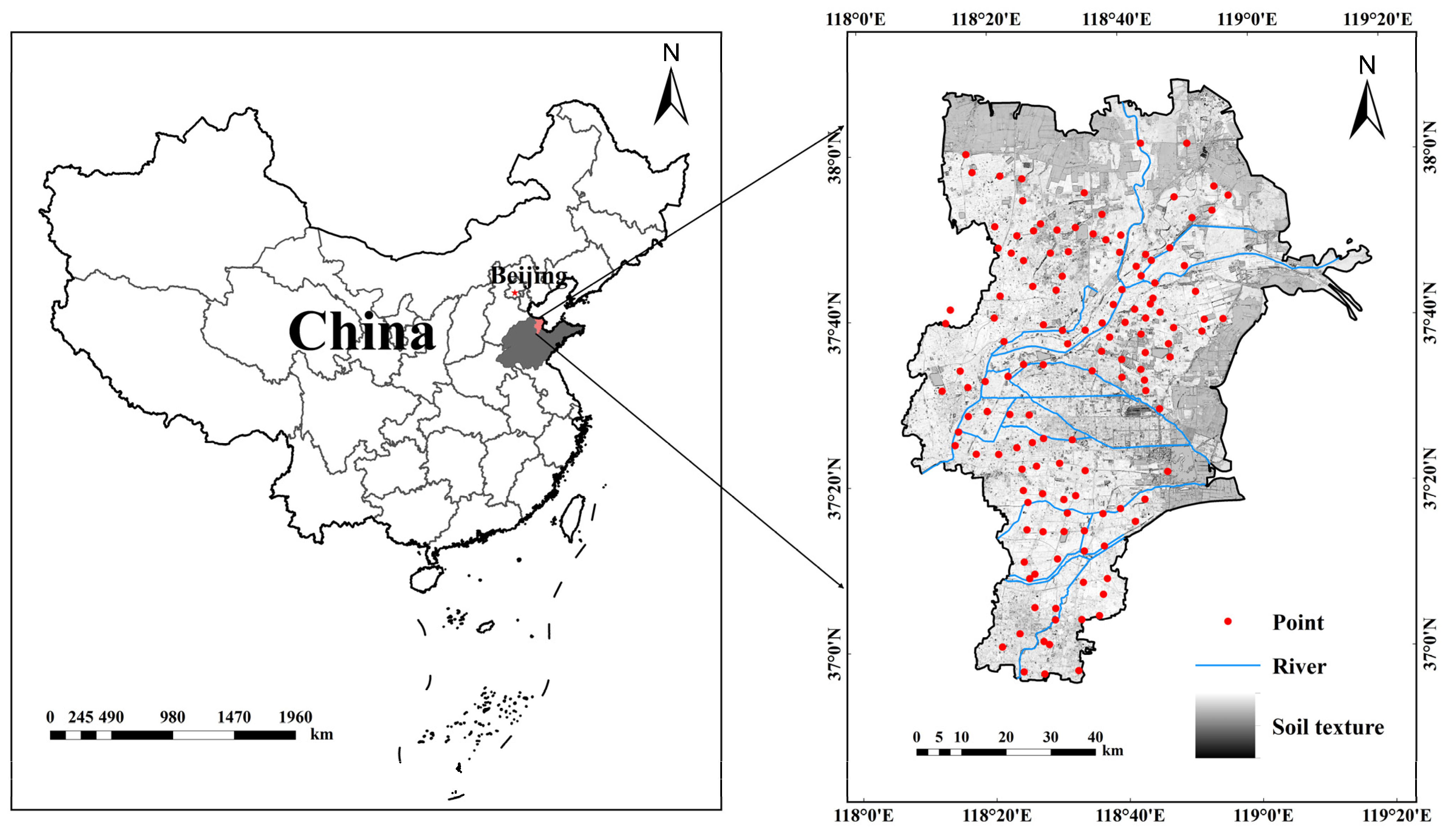


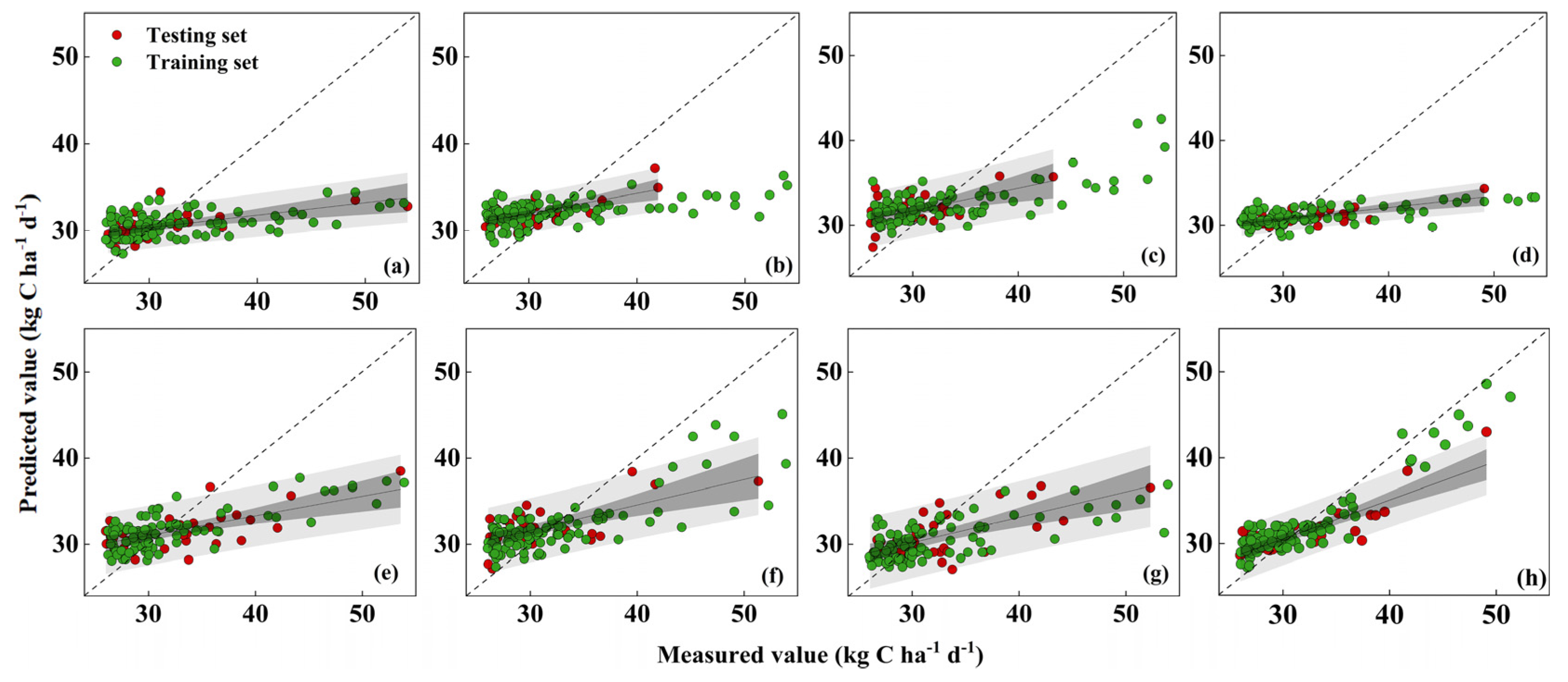
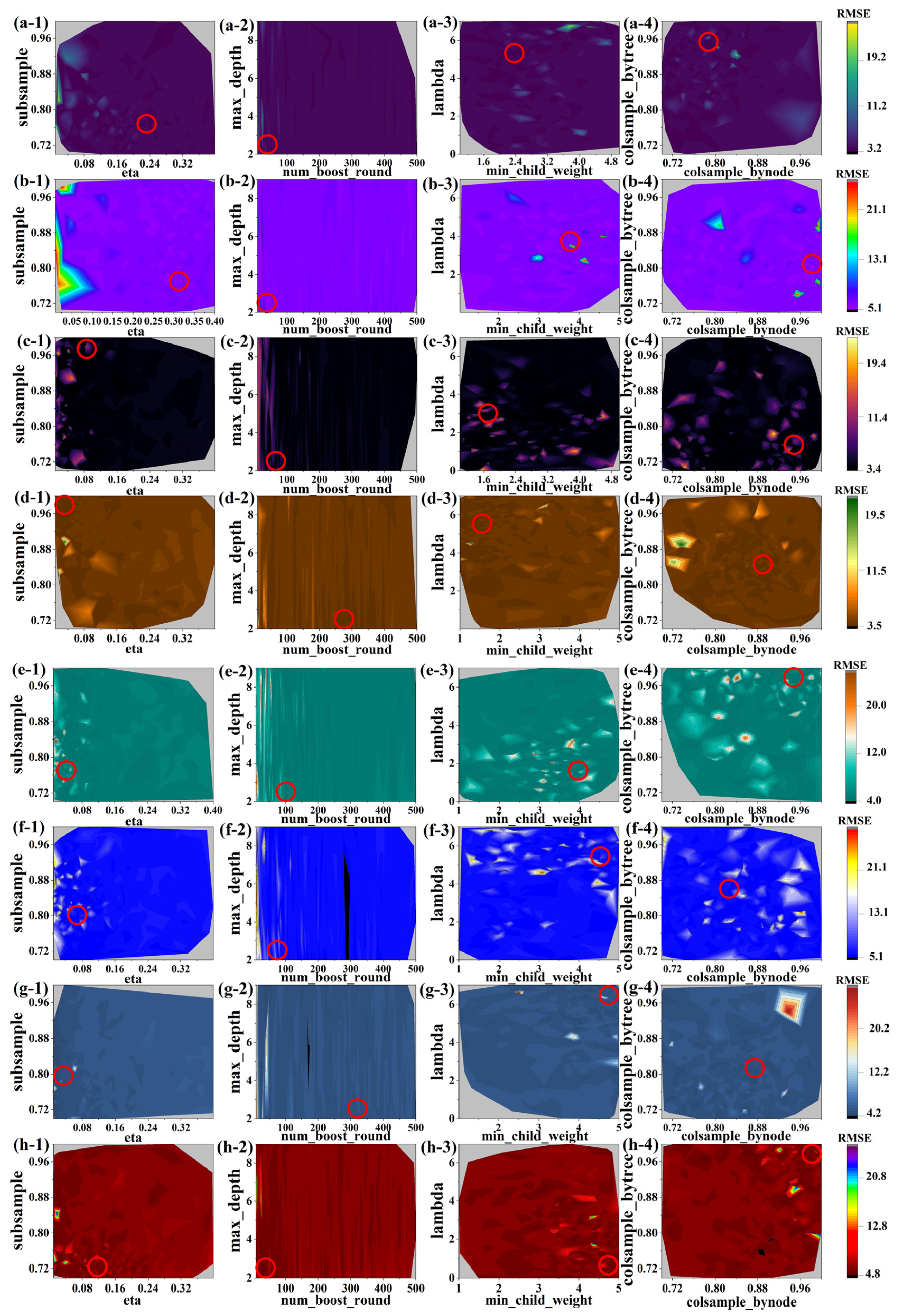
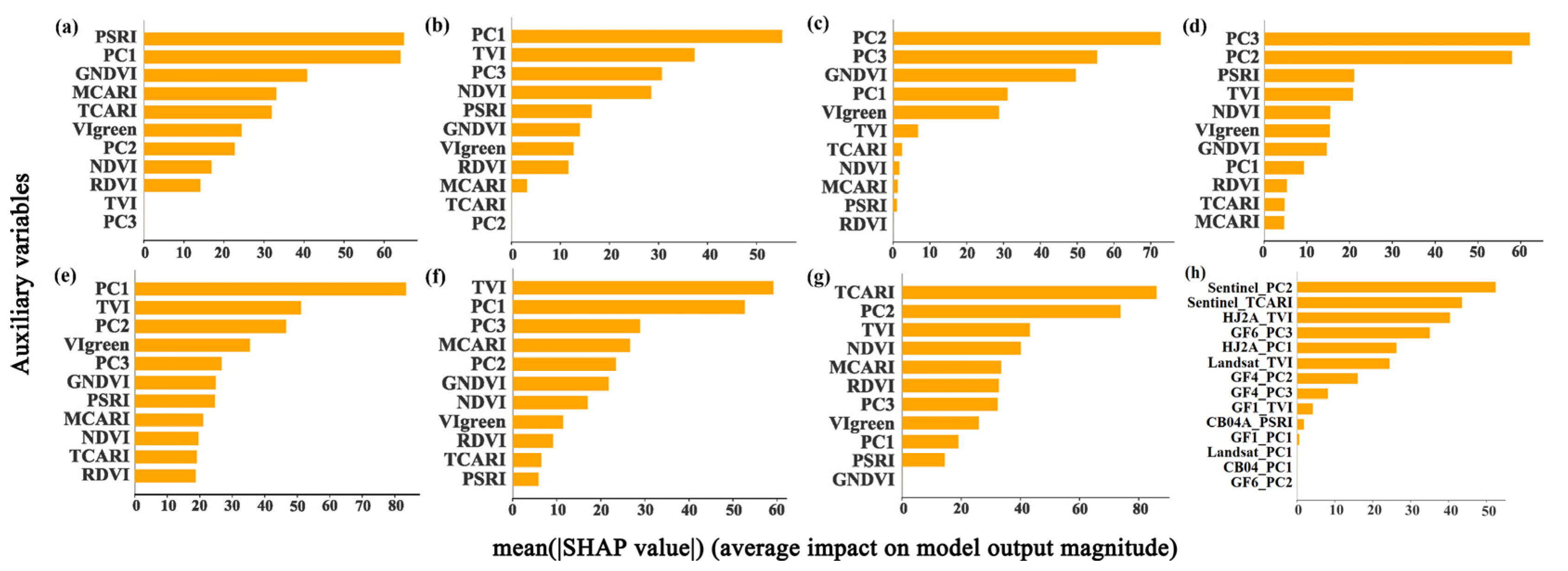
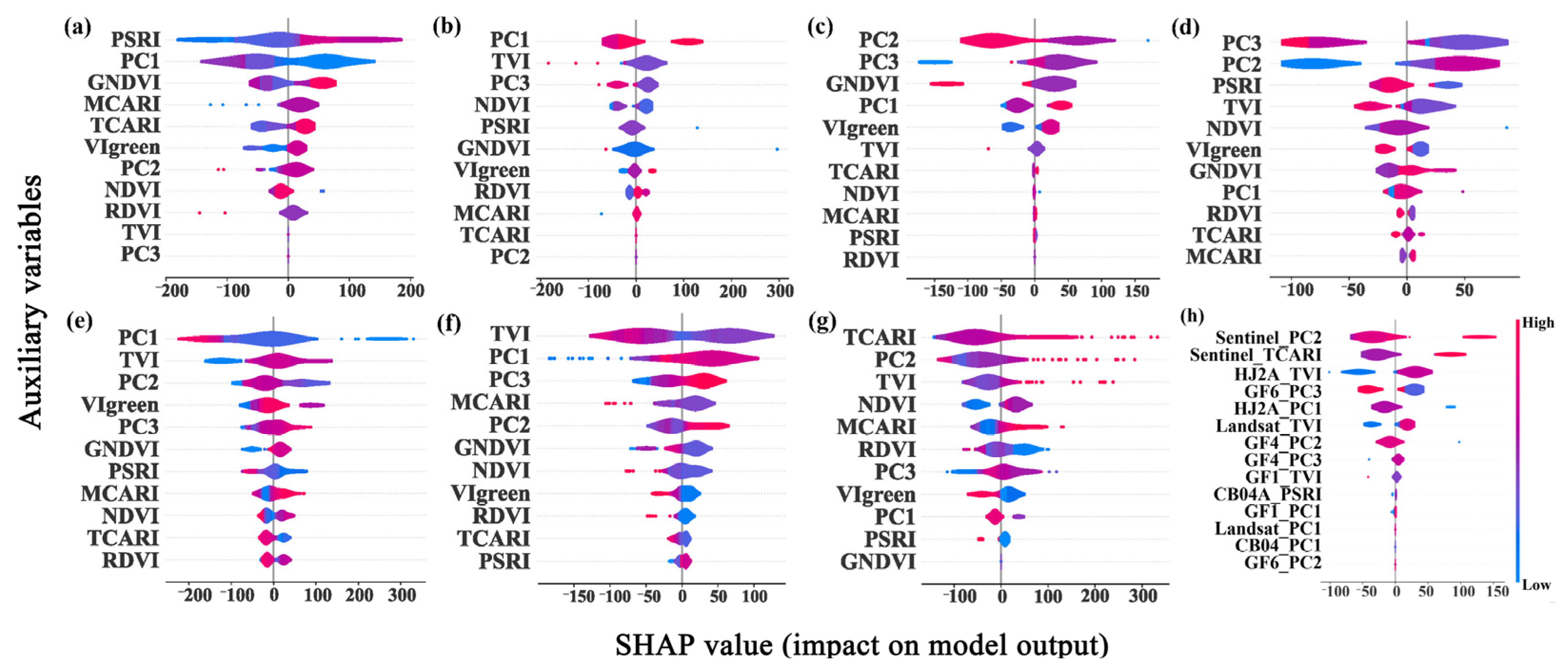

| Image and Resolution (m) | Band Serial Number and Wavelength/Center Wavelength (μm) |
|---|---|
| GF1-WFV (16) | B1 (0.45–0.52), B2 (0.52–0.59), B3 (0.63–0.69), B4 (0.77–0.89) |
| GF6-WFV (16) | B1 (0.45–0.52), B2 (0.52–0.59), B3 (0.63–0.69), B4 (0.77–0.89), B5 (0.69–0.73), B6 (0.73–0.77), B7 (0.40–0.45), B8 (0.59–0.63) |
| GF4-PMI (400) | B2 (0.519), B3 (0.550), B4 (0.628), B5 (0.770) |
| CB04-MUX (17) | B1 (0.45–0.52), B2 (0.52–0.59), B3 (0.63–0.69), B4 (0.77–0.89) |
| HJ2A-CCD (30) | B1 (0.485), B2 (0.555), B3 (0.660), B4 (0.830), B5 (0.710) |
| Sentinel 2-L2A (10) | B1 (0.443), B2 (0.490), B3 (0.560), B4 (0.665), B5 (0.705), B6 (0.740), B7 (0.783), B8 (0.842), B8A (0.865), B9 (0.945), B10 (1.375), B11 (1.610) |
| Landsat 8-OLI (30) | B1 (0.43–0.45), B2 (0.45–0.51), B3 (0.53–0.59), B4 (0.64–0.67), B5 (0.85–0.88), B6 (1.57–1.65), B7 (2.11–2.29), B9 (1.36–1.38) |
| Index | Formula | Reference |
|---|---|---|
| MCARI | [25] | |
| TVI | [26] | |
| TCARI | [27] | |
| RDVI | [28] | |
| VIgreen | [29] | |
| PSRI | [30] | |
| GNDVI | [31] | |
| NDVI | [32] |
| Hyperparameters | Type | Range | Explanation |
|---|---|---|---|
| subsample | float | (0.72, 1) | The proportion of random sampling per tree |
| num_boost_round | int | (50, 500) | The number of boosting iterations during the training process |
| eta | float | (0.04, 0.36) | The learning rate |
| lambda | float | (0, 7) | The regularization part of XGBoost processing |
| min_child_weight | float | (1.2, 4.8) | The sum of weights of the minimum leaf node sample |
| colsample_bytree | float | (0.72, 1) | The proportion of features used for training to all features |
| colsample_bynode | float | (0.72, 1) | The subsampling rate of each node split column |
| max_depth | int | (2, 9) | The maximum depth of a tree |
| STD (kg C ha−1 d−1) | RMSE (kg C ha−1 d−1) | R² | ||
|---|---|---|---|---|
| GF1-WFV | Testing set | 1.36 | 3.46 | 0.41 |
| Training set | 1.33 | 6.27 | 0.28 | |
| GF6-WFV | Testing set | 0.90 | 3.94 | 0.45 |
| Training set | 1.03 | 6.34 | 0.36 | |
| GF4-PMI | Testing set | 1.77 | 3.49 | 0.29 |
| Training set | 2.20 | 5.51 | 0.50 | |
| CB04-MUX | Testing set | 1.39 | 5.15 | 0.36 |
| Training set | 1.43 | 6.11 | 0.22 | |
| HJ2A-CCD | Testing set | 2.14 | 5.10 | 0.42 |
| Training set | 2.22 | 4.90 | 0.57 | |
| Sentinel 2-L2A | Testing set | 2.59 | 4.87 | 0.45 |
| Training set | 2.16 | 5.42 | 0.47 | |
| Landsat 8-OLI | Testing set | 2.31 | 4.12 | 0.43 |
| Training set | 3.17 | 4.57 | 0.62 | |
| All | Testing set | 2.75 | 3.23 | 0.73 |
| Training set | 4.09 | 2.29 | 0.87 |
Disclaimer/Publisher’s Note: The statements, opinions and data contained in all publications are solely those of the individual author(s) and contributor(s) and not of MDPI and/or the editor(s). MDPI and/or the editor(s) disclaim responsibility for any injury to people or property resulting from any ideas, methods, instructions or products referred to in the content. |
© 2024 by the authors. Licensee MDPI, Basel, Switzerland. This article is an open access article distributed under the terms and conditions of the Creative Commons Attribution (CC BY) license (https://creativecommons.org/licenses/by/4.0/).
Share and Cite
Yu, W.; Chen, S.; Yang, W.; Song, Y.; Lu, M. Spatial Mapping of Soil CO2 Flux in the Yellow River Delta Farmland of China Using Multi-Source Optical Remote Sensing Data. Agriculture 2024, 14, 1453. https://doi.org/10.3390/agriculture14091453
Yu W, Chen S, Yang W, Song Y, Lu M. Spatial Mapping of Soil CO2 Flux in the Yellow River Delta Farmland of China Using Multi-Source Optical Remote Sensing Data. Agriculture. 2024; 14(9):1453. https://doi.org/10.3390/agriculture14091453
Chicago/Turabian StyleYu, Wenqing, Shuo Chen, Weihao Yang, Yingqiang Song, and Miao Lu. 2024. "Spatial Mapping of Soil CO2 Flux in the Yellow River Delta Farmland of China Using Multi-Source Optical Remote Sensing Data" Agriculture 14, no. 9: 1453. https://doi.org/10.3390/agriculture14091453




